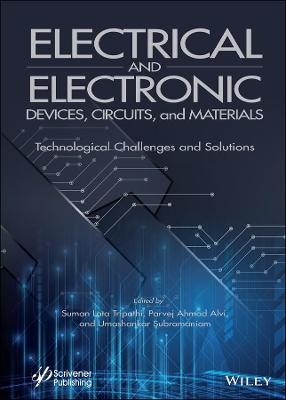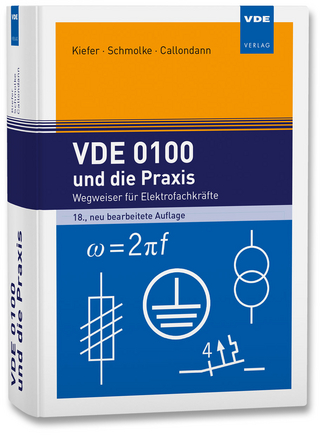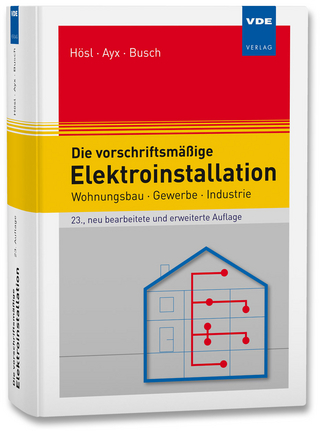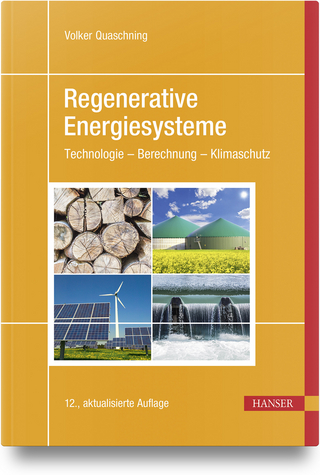
Electrical and Electronic Devices, Circuits, and Materials
Wiley-Scrivener (Verlag)
978-1-119-75036-9 (ISBN)
- Titel z.Zt. nicht lieferbar
- Versandkostenfrei innerhalb Deutschlands
- Auch auf Rechnung
- Verfügbarkeit in der Filiale vor Ort prüfen
- Artikel merken
This outstanding new volume presents the basic concepts and fundamentals behind devices, circuits, and systems. It is a valuable reference for the veteran engineer and a learning tool for the student, the practicing engineer, or an engineer from another field crossing over into electrical engineering. It is a must-have for any library.
Suman Lata Tripathi, PhD, is a professor at Lovely Professional University with more than seventeen years of experience in academics. She has published more than 45 research papers in refereed journals and conferences. She has organized several workshops, summer internships, and expert lectures for students, and she has worked as a session chair, conference steering committee member, editorial board member, and reviewer for IEEE journals and conferences. She has published one edited book and currently has multiple volumes scheduled for publication, including volumes available from Wiley-Scrivener. Parvej Ahmad Alvi, PhD, is an associate professor in the Department of Physics at Banasthali University, Rajasthan, India. He has more than 14 years of teaching and research experience in the area of modern physics, semiconductor physics, and nanotechnology. He has worked as an editorial board member and reviewer on several journals and conferences and has published more than 100 research papers in refereed international journals and conferences. He also has six books to his credit. Umashankar Subramaniam, PhD, is an associate professor at the Renewable Energy Lab, College of Engineering, Prince Sultan University, Saudi Arabia. He has over 15 years of teaching, research and industrial experience. He is an Associate Editor at the journal, IEEE Access, and is an editor on the journal, Heliyon, along with other jorunals. He has published more than 250 research papers in academic journals and conferences and has also contributed to over a dozen books.
Preface xvii
Part I Design and Analysis 1
1 Strain Engineering in Modern Field Effect Transistors 3
Kunal Sinha
1.1 Introduction 3
1.2 Theory of Strain Technology 4
1.2.1 Stress and Strain 4
1.2.2 Stress Matrix for Biaxial and Uniaxial Stress 6
1.2.3 Impact of Strain on MOSFET Parameters 8
1.3 Simulation Studies in Strain Technology 9
1.4 Experimental Studies on Strain Technology 12
1.5 Summary and Future Scope 14
Future Scope 15
Acknowledgement 15
References 15
2 Design and Optimization of Heterostructure Double Gate Tunneling Field Effect Transistor for Ultra Low Power Circuit and System 19
Guenifi Naima and Shiromani Balmukund Rahi
2.1 Introduction 19
2.2 Fundamental of Device Physics 20
2.2.1 Basic Working Principles of TFET 20
2.2.2 Kane’s Model 21
2.3 Analysis Approach and Device Parameters 21
2.4 Switching Behavior of TFET 23
2.5 Results and Discussion 24
2.6 Conclusion 34
Acknowledgement 35
References 35
3 Polymer Electrolytes: Development and Supercapacitor Application 37
Anil Arya, Anurag Gaur and A. L. Sharma
3.1 Introduction 37
3.1.1 The Basic Principle and Types of Supercapacitors 38
3.1.2 Key Characteristics of the Electrolyte 40
3.1.3 Polymer Electrolytes and Types 43
3.1.4 Modification Strategies for Polymer Electrolytes 46
3.2 Preparation and Characterization Techniques 47
3.3 Latest Developments 51
3.4 Summary 62
References 62
4 Tunable RF/Microwave Filter with Fractal DGS 67
Mehul Thakkar, Pravin R. Prajapati and Hitesh Shah
4.1 Introduction 67
4.2 Literature Review 70
4.2.1 Planar Reconfigurable Filters 70
4.3 Proposed Work 71
4.3.1 Design of Hairpin Bandpass Filter 71
4.3.2 Design of Hairpin Bandpass Filter with Fractal DGS 72
4.3.3 Design of Tunable Hairpin Bandpass Filter with Fractal DGS 76
4.4 Conclusion 80
Acknowledgement 80
References 80
5 GaN High Electron Mobility Transistor Device Technology for RF and High-Power Applications 83
A. B. Khan
5.1 Introduction 83
5.2 HEMT Structures 85
5.2.1 GaAs-Based HEMTs 85
5.2.2 InP-Based HEMTs 85
5.2.3 GaN-Based HEMTs 86
5.3 Polarization Impact and Creation of 2DEG in GaN HEMT 88
5.3.1 Polarization Effect 88
5.3.2 Formation of 2DEG 90
5.4 GaN-Based HEMT Performance Affecting Factors 92
5.4.1 Surface Passivation 92
5.4.2 Parasitic Effects 93
5.4.3 Field Plate Engineering Technique 94
5.4.4 Impact of Barrier Layer 95
5.5 Conclusion 95
References 96
6 Design and Analyses of a Food Protein Sensing System Based on Memristive Properties 101
Rupam Goswami, Arighna Deb, Rithik Dilip Rathi and Prateek Mahajan
6.1 Introduction 101
6.2 Background 103
6.2.1 Principle of a Memristor 103
6.2.2 Bio-Memristors 103
6.2.3 Applications of Memristors 104
6.3 Motivation 105
6.4 Experimental Set-Up 105
6.5 Experimental Methodology and Preliminary Validation 106
6.5.1 Experimental Methodology 106
6.5.1.1 Food Items 106
6.5.1.2 Reading Voltage and Current Values 107
6.5.2 Preliminary Validation 107
6.6 Sensitivity Parameters 108
6.6.1 Resistance-Based Sensitivity (Sr) 108
6.6.2 Point Slope-Based Sensitivity (Sm) 108
6.6.3 Hysteresis-Line Slope Sensitivity 109
6.7 Results and Discussion 110
6.7.1 Category I: Egg Albumin and Milk 110
6.7.2 Category II: Protein Blend 113
6.8 Conclusions and Prospects 114
References 115
7 Design of Low-Power DRAM Cell Using Advanced FET Architectures 119
A. Durgesh and Suman Lata Tripathi
7.1 Introduction 119
7.2 1T-DRAM (MOS) 120
7.3 1T-DRAM (CNT-FET) 123
7.4 1T-DRAM (FinFET) 124
7.5 1-T DRAM (TFET) 128
7.6 Conclusion 130
References 131
8 Application of Microwave Radiation in Determination of Quality Sensing of Agricultural Products 133
Dr. Ravika Vijay, Dr. Nidhi Bhargava and Prof. K. S. Sharma
8.1 Microwave Heating and its Applications to Agricultural Products 133
8.1.1 Principle of Microwave Heating 133
8.1.2 Moisture Sensing 135
8.1.3 Promoting Germination 136
8.1.4 Food Processing 136
8.1.5 Weeds, Insects and Pests Control 136
8.1.6 Product Conditioning 136
8.1.7 Microwave Drying 137
8.1.8 Quality Sensing in Fruits and Vegetables 137
8.2 Measurement Techniques 137
8.2.1 Open-Ended Coaxial Probe – Network Analyzer Technique 138
8.2.2 Network Analyzer 139
8.3 Dielectric Spectroscopy of Agricultural Products at Different Temperatures 140
8.4 Correlation of Dielectric Properties with Nutrients 148
8.5 Conclusion 151
References 151
9 Solar Cell 155
Dr. Arvind Dhingra
Introduction 155
9.1 History of Solar Cell 155
9.2 Constructional Features of Solar Cell 158
9.3 Criteria for Materials to Be Used in Manufacturing of Solar Cell 158
9.4 Types of Solar Cells 159
9.5 Process of Making Crystals for Solar Cell Manufacturing 160
9.6 Glass 161
9.7 Cell Combinations 161
9.7.1 Series Combination of Solar Cells 161
9.7.2 Parallel Combination of Solar Cells 162
9.7.3 Series-Parallel Combination of Solar Cells 163
9.8 Solar Panels 164
9.9 Working of Solar Cell 165
9.10 Solar Cell Efficiency 166
9.11 Uses/Applications of Solar Cells 166
Conclusion 167
References 167
10 Fabrication of Copper Indium Gallium Diselenide (Cu(In,Ga)Se2) Thin Film Solar Cell 169
Jaymin Ray, Keyur Patel, Gopal Bhatt, Priya Suryavanshi and C. J. Panchal
10.1 Introduction 169
10.2 Device Structure of CIGS Thin Film Solar Cell 170
10.3 Fabrication and Characterization of CIGS Thin Film Solar Cell 171
10.3.1 Effect of Thermally Evaporated CdS Film Thickness on the Operation of CIGS Solar Cell 174
10.3.2 Effect of Heat Soaks on CIGS/CdS Hetero-Junction 175
10.3.3 Effect of Flash Evaporated CdS Film Thickness on the Performance of CIGS Solar Cell 176
10.3.4 Effect of i-ZnO Film Thickness on the Performance of CIGS Solar Cell 179
10.4 Conclusion 186
References 186
11 Parameter Estimation of Solar Cells: A Multi-Objective Approach 189
Saumyadip Hazra and Souvik Ganguli
11.1 Introduction 189
11.2 Problem Statement 191
11.2.1 SDM 192
11.2.2 DDM 194
11.3 Methodology 196
11.4 Results and Discussions 197
11.4.1 Results for the Single-Diode Model 198
11.4.2 Results for Double-Diode Model 203
11.5 Conclusions 208
References 209
12 An IoT-Based Smart Monitoring Scheme for Solar PV Applications 211
Senthil Kumar Ramu, Gerald Christopher Raj Irudayaraj and Rajarajan Elango
12.1 Introduction 211
12.2 Solar PV Systems 213
12.2.1 Solar Photovoltaic (PV) Systems 213
12.2.1.1 Stand-Alone PV Modules 214
12.2.1.2 Grid-Connected PV Systems 214
12.2.2 Concentrates Solar Power (CSP) 214
12.2.3 Solar Water Heater Systems 215
12.2.4 Passive Solar Design 216
12.2.5 Solar Microgrid System 216
12.2.5.1 PV Module 217
12.2.6 Battery 217
12.2.6.1 Flooded Lead Acid Battery 218
12.2.6.2 VRLA Battery 219
12.2.6.3 Lithium-Ion Battery 219
12.2.7 MPPT 219
12.2.8 Inverters & Other Electronic Equipment 219
12.2.9 Charge Controller 220
12.2.10 Additional Systems Equipment 220
12.3 IoT 220
12.3.1 Artificial Intelligence (AI) and Machine Learning 221
12.3.1.1 Hardware 221
12.3.1.2 Middleware 221
12.3.1.3 Cloud 221
12.3.2 Big Data and Cloud Computing 221
12.3.3 Smart Sensors 221
12.3.3.1 Temperature Sensor 221
12.3.3.2 Humidity Sensor 222
12.3.3.3 Tilt Sensor 223
12.3.3.4 CO2 Sensor 223
12.3.3.5 Voltage and Current Sensor 223
12.3.3.6 Light Sensor 223
12.3.3.7 MEMS (Micro Electro Mechanical Systems) Sensor 223
12.3.3.8 Ultrasonic Sensor 223
12.3.3.9 IR Sensor 224
12.3.3.10 Proximity Sensor 224
12.3.4 Additional Devices for Control and Communication 224
12.3.4.1 Arduino 224
12.3.4.2 Raspberry Pi 224
12.3.4.3 GSM Module 225
12.3.5 Renewable Energy and IoT in Energy Sector 225
12.3.6 Application of IoT 226
12.3.6.1 Application to Renewable Energy Systems 226
12.3.6.2 Application to Grid Management 227
12.4 Remote Monitoring Methods of Solar PV System 228
12.4.1 Wireless Monitoring 228
12.4.2 Physical/Wired Monitoring 228
12.4.3 SCADA Monitoring 228
12.4.4 Monitoring Using Cloud Computing 228
12.4.5 Monitoring Using IOT 228
12.4.5.1 IoT-Based Remote Monitoring 229
12.5 Challenges and Issues of Implementation of IoT on Renewable Energy Resources 230
12.5.1 Challenges 230
12.5.2 Solutions 231
12.6 Conclusion 231
References 231
13 Design of Low-Power Energy Harvesting System for Biomedical Devices 235
Dr. R. Seyezhai and S. Maheswari
13.1 Introduction 235
13.2 Investigation on Topologies of DC-DC Converter 236
13.2.1 Hybrid Source Architecture Based on Synchronous Boost Converter 236
13.2.2 Hybrid Source Architecture Using Single-Inductor Dual-Input Single-Output Converter 237
13.2.3 Hybrid Source Architecture Employing a Multi-Input DC Chopper 239
13.3 Hardware Results 246
13.4 Conclusion 247
References 247
14 Performance Analysis of Some New Hybrid Metaheuristic Algorithms for High-Dimensional Optimization Problems 251
Souvik Ganguli, Gagandeep Kaur and Prasanta Sarkar
14.1 Introduction 251
14.2 An Overview of Proposed Hybrid Methodologies 253
14.3 Experimental Results and Discussion 256
14.4 Conclusions 282
References 283
15 Investigation of Structural, Optical and Wettability Properties of Cadmium Sulphide Thin Films Synthesized by Environment Friendly SILAR Technique 285
Sampat G. Deshmukh, Rohan S. Deshmukh and Vipul Kheraj
15.1 Introduction 285
15.2 Experimental Details 286
15.3 Results and Discussion 288
15.3.1 Film Formation Mechanism 288
15.3.2 Thickness Measurement 289
15.3.3 Structural Studies 289
15.3.4 Raman Spectroscopy 292
15.3.5 Scanning Electron Microscopy 293
15.3.6 Optical Studies 294
15.3.7 Wettability Studies 295
15.4 Conclusion 296
15.5 Acknowledgement 296
References 296
Part II Design, Implementation and Applications 299
16 Solar Photovoltaic Cells 301
V. Mohanapriya and V. Manimegalai
16.1 Introduction 301
16.2 Need for Solar Cells 302
16.3 Structure of Solar Cell 302
16.4 Solar Cell Classification 303
16.4.1 First-Generation Solar Cells 303
16.4.2 Second-Generation Solar Cells 304
16.4.3 Third-Generation Solar Cells 304
16.5 Solar PV Cells 305
16.6 Solar Cell Working 306
16.7 Mathematical Modelling of Solar Cell 306
16.8 Solar Cell Connection Methods 309
16.9 Types of Solar PV System 311
16.10 Conclusion 313
References 313
17 An Intelligent Computing Technique for Parameter Extraction of Different Photovoltaic (PV) Models 315
Shilpy Goyal, Parag Nijhawan and Souvik Ganguli
17.1 Introduction 315
17.2 Problem Formulation 317
17.2.1 Single-Diode Model 317
17.2.2 Double-Diode Model 319
17.2.3 Three-Diode Model 320
17.3 Proposed Optimization Technique 322
17.3.1 Various Phases of Optimization of Harris Hawks 323
17.3.1.1 Exploration Phase 323
17.3.1.2 Turning from Global to Local Search 324
17.3.1.3 Exploitation Phase 324
17.4 Results and Discussions 324
17.5 Conclusions 339
References 339
18 Experimental Investigation on Wi-Fi Signal Loss by Scattering Property of Duranta Plant Leaves 341
Khalid Ali Khan, Syed Gulraze Anjum, M. Nasim Faruque and Dinkisa Dechasa Geyesa
18.1 Introduction 341
18.1.1 Duranta Golden Plant 342
18.1.2 Foliage Loss 343
18.2 Measurement and Calculation 343
18.2.1 Scattering Feasibility 346
18.2.2 Comparison with Tree Shadowing Effect 347
18.3 Result and Discussion 347
18.4 Conclusions 348
References 348
19 Multi-Quantum Well-Based Solar Cell 351
Ashish Raman, Chetan Chaturvedi and Naveen Kumar
19.1 Introduction 351
19.2 Theoretical Aspects of Solar Cell 353
19.3 Device Design and Simulation Setup 354
19.4 Results and Discussion 356
19.4.1 GaSb/GaAs MQWs Solar Cell 356
19.4.2 InGaP/GaAs MQW Solar Cell 358
19.4.3 InP/GaAs MQW Solar Cell 360
19.4.4 AlGaAs/GaAs MQW Solar Cell 361
19.4.5 Optimization 363
19.5 Comparative Analysis 367
19.6 Conclusion 370
References 370
20 Mitigation Techniques for Removal of Dust on Solar Photovoltaic System 373
Pandiyan P, Saravanan S, Chinnadurai T, Ramji Tiwari, Prabaharan N and Umashankar S
20.1 Introduction 373
20.2 Influencing Factors for Deposition of Dust 375
20.2.1 Ecological Factors 375
20.2.1.1 Direction of Wind and its Velocity 375
20.2.1.2 Temperature and Moisture 376
20.2.1.3 Humidity 377
20.2.1.4 Rainfall 377
20.2.1.5 Dust Properties 377
20.2.1.6 Bird Droppings 378
20.2.2 Factors Influencing Installation 378
20.2.2.1 Orientation and Tilt Angle 378
20.2.2.2 Height 378
20.2.2.3 Top Surface of the Solar Panels 378
20.2.3 Installed Location and Exposure Time 379
20.3 Effects of Deposition of Dust on the Solar Panels 379
20.3.1 Influence of Electrical Characteristics 379
20.3.2 Influence of the Optical Characteristics 380
20.3.3 Influence of the Thermal Characteristic 381
20.4 Methods of Cleaning System 381
20.4.1 Natural Cleaning Method 384
20.4.2 Manual Cleaning Method 384
20.4.3 Self-Cleaning Method 385
20.4.3.1 Active Cleaning 385
20.4.3.2 Passive Cleaning 388
20.5 Conclusion 389
References 389
21 Solid-State Air-Conditioning System Using Photovoltaic Module 393
Dr. Y. Thiagarajan, S. Karthikeyan, K. Santhosh, M. Keerthana and Gabriel Gomes de Oliveira
21.1 Introduction 393
21.1.1 Thermoelectric Cooler (TEC) 394
21.2 Fabrication of the Solid State Air-Conditioning System 395
21.2.1 Description of the Proposed Model 395
21.2.2 Peltier Effect 395
21.2.3 Comparison Between the Existing Framework and Proposed System 396
21.3 Hardware Implementation 396
21.3.1 8051 Architecture 396
21.3.2 Microcontroller PCB 397
21.3.3 Photovoltaic Module 397
21.3.4 Solar Radiation 397
21.3.5 Battery 398
21.3.6 Relay 399
21.3.7 5×1 Keypad 400
21.3.8 Peltier Sensor 400
21.3.9 Solenoid Valve 400
21.4 Software Analysis 400
21.4.1 KEIL Compiler 401
21.4.2 Gathering with Cx51 401
21.4.3 Running Cx51 from the Command Prompt 401
21.4.4 Program for AT89S52 402
21.4.4.1 Solar Coding 402
21.4.4.2 Peltier Coding 406
21.5 Conclusion 409
References 409
22 Cu2ZnSnS4 Thin Film Solar Cell: Fabrication and Characterization 411
Kinjal Patel, Neelkanth G. Dhere, Vipul Kheraj and Dimple Shah
22.1 Introduction 411
22.1.1 Solar Photovoltaics: A Key to Energy Elucidation 412
22.1.2 Thin Film Solar Cells 413
22.1.3 CZTS Solar Cells 414
22.2 Fabrication of Cu2ZnSnS4 Thin Film Solar Cell 415
22.2.1 Glass Cleaning 416
22.2.2 Molybdenum Deposition 417
22.2.3 CZTS Thin Film Coating 417
22.2.4 CdS Deposition 417
22.2.5 ZnO and Al-ZnO Coating 418
22.2.6 Chromium/Silver Front Contact Grid 418
22.2.7 CZTS Solar Cell Device 419
22.3 Characterization of Cu2ZnSnS4 Thin Film Solar Cell 420
22.3.1 Typical Solar Cell Characterizations 420
22.3.2 Current-Voltage (I-V) Measurement 421
22.3.3 Quantum Efficiency (QE) 423
22.4 Conclusion 424
Acknowledgement 425
References 425
23 Parameter Estimation of Solar Cell Using Gravitational Search Algorithm 427
Kaustuv Das, Raju Basak, Souvik Ganguli and Asoke Kumar Paul
23.1 Introduction 427
23.2 Modelling of Photovoltaic Unit 429
23.2.1 Two-Diode Structure 430
23.3 Formation of Function 431
23.4 Gravitational Search Algorithm 433
23.4.1 The Gravitational Search Algorithm is Shown in Steps as Follows 435
23.5 Review of GSA 436
23.6 Application of GSA 436
23.7 Summary and Future Scope of Work 436
23.8 Particle Swarm Optimization (PSO) 437
23.8.1 Steps Involved for Particle Swarm Optimization 439
23.9 Results and Discussion 439
23.10 Conclusion 443
References 443
24 Study of the Most Commonly Utilized Maximum Power Point (MPP) Tracking (MPPT) Schemes for SPV Systems 447
Pawan Kumar Pathak, Anil Kumar Yadav and P. A. Alvi
24.1 Introduction 447
24.2 Problem Overview in SPV Power Extraction 448
24.3 Modeling of SPV System 449
24.4 MPPT Schemes 451
24.4.1 Perturb and Observe (P&O) 451
24.4.2 Incremental Conductance 455
24.4.3 Fuzzy Logic (FL) Based 459
24.4.4 Hybrid 466
24.5 Conclusion 470
References 470
25 An Investigation and Design of Symmetric and Asymmetric Inverter for Various Applications 473
L. Vijayaraja, S. Ganesh Kumar and M. Rivera
25.1 Introduction 473
25.2 Evaluation of Multilevel Inverters and Its Application in Recent Times 474
25.3 Design of 15-Level Inverter With Symmetric Voltage Source 476
25.4 Experimentation of 27-Level Symmetric Inverter 477
25.5 Design of 31-Level Inverter Using Asymmetric Voltage Sources 482
25.5.1 Mathematical Model of 31-Level Inverter 483
25.6 Development of 53-Level Inverter Using Packed Structures 487
25.7 Summary 491
References 491
26 A Demand Side Management Controller Configuration for Interleaved DC-DC Converters Applicable for Renewable Energy Sources 493
Davood Ghaderi, Gökay Bayrak and Umashankar Subramaniam
26.1 Introduction 493
26.2 Control Method and Proposed Controller Investigation 496
26.2.1 Power Sharing and Demand Side Management 501
26.3 Simulation Results 504
26.4 Experimental Results 508
26.5 Conclusion 512
References 514
27 Applications of Hybrid Wind Solar Battery Based Microgrid for Small-Scale Stand-Alone Systems and Grid Integration for Multi-Feeder Systems 517
P. Satish Kumar
27.1 Introduction 517
27.2 Stand-Alone HRES System 518
27.2.1 System Description 518
27.2.2 Results and Discussion 520
27.2.2.1 Performance of HRES During Source Variations Only 520
27.2.2.2 Performance of HRES During Load Variations Only 523
27.2.3 Conclusion 523
27.3 Grid-Connected HRES System 525
27.3.1 System Description 525
27.3.2 Results and Discussion 525
27.3.2.1 HRES Output 526
27.3.2.2 Performance of Grid-Connected HRES for Nonlinear Loads 528
27.3.2.3 Performance of Grid-Connected HRES for Source Voltage Imperfections 529
27.3.3 Conclusion 530
Acknowledgements 531
References 533
28 Challenging Issues and Solutions on Battery Thermal Management for Electric Vehicles 535
A. Gayathri, V. Manimegalai and P. Krishnakumar
28.1 Introduction 535
28.2 Principle and Working of Battery 536
28.3 Types of Batteries 536
28.3.1 Primary or Non-Rechargeable Batteries 537
28.3.2 Secondary or Rechargeable Batteries 537
28.3.2.1 Lead-Acid Batteries 538
28.3.2.2 Nickel Cadmium (Ni-Cd) 538
28.3.2.3 Nickel-Metal Hydride (Ni-MH) 538
28.3.2.4 Lithium-Ion (Li-Ion) 539
28.3.3 Selection of Batteries 539
28.3.3.1 Why Lithium-Ion Battery? 540
28.4 Thermal Behavior of Batteries 542
28.5 Battery Thermal Management Systems 543
28.6 Methods of Battery Thermal Management Systems 544
28.6.1 Air Cooling BTMS 544
28.6.2 Liquid Cooling BTMS 546
28.6.3 Refrigerant Direct Cooling System BTMS 547
28.6.4 Phase Change Material-Based BTMS 548
28.6.5 Heat Pipe-Based BTMS 549
28.6.6 Thermoelectric Cooling 550
28.7 Conclusion 551
References 551
Index 555
| Erscheinungsdatum | 23.04.2021 |
|---|---|
| Sprache | englisch |
| Maße | 10 x 10 mm |
| Gewicht | 454 g |
| Themenwelt | Technik ► Elektrotechnik / Energietechnik |
| Technik ► Maschinenbau | |
| ISBN-10 | 1-119-75036-9 / 1119750369 |
| ISBN-13 | 978-1-119-75036-9 / 9781119750369 |
| Zustand | Neuware |
| Informationen gemäß Produktsicherheitsverordnung (GPSR) | |
| Haben Sie eine Frage zum Produkt? |
aus dem Bereich


